Human Resource Management in Developing Countries
VerifiedAdded on 2020/06/04
|14
|4147
|199
AI Summary
This assignment delves into the complex world of Human Resource Management (HRM) within developing countries. It examines various theoretical perspectives and practical challenges faced by organizations in these regions. The analysis encompasses topics such as strategic HRM, talent management, performance appraisal, compensation and benefits, employee relations, and legal considerations specific to developing countries.
Contribute Materials
Your contribution can guide someone’s learning journey. Share your
documents today.
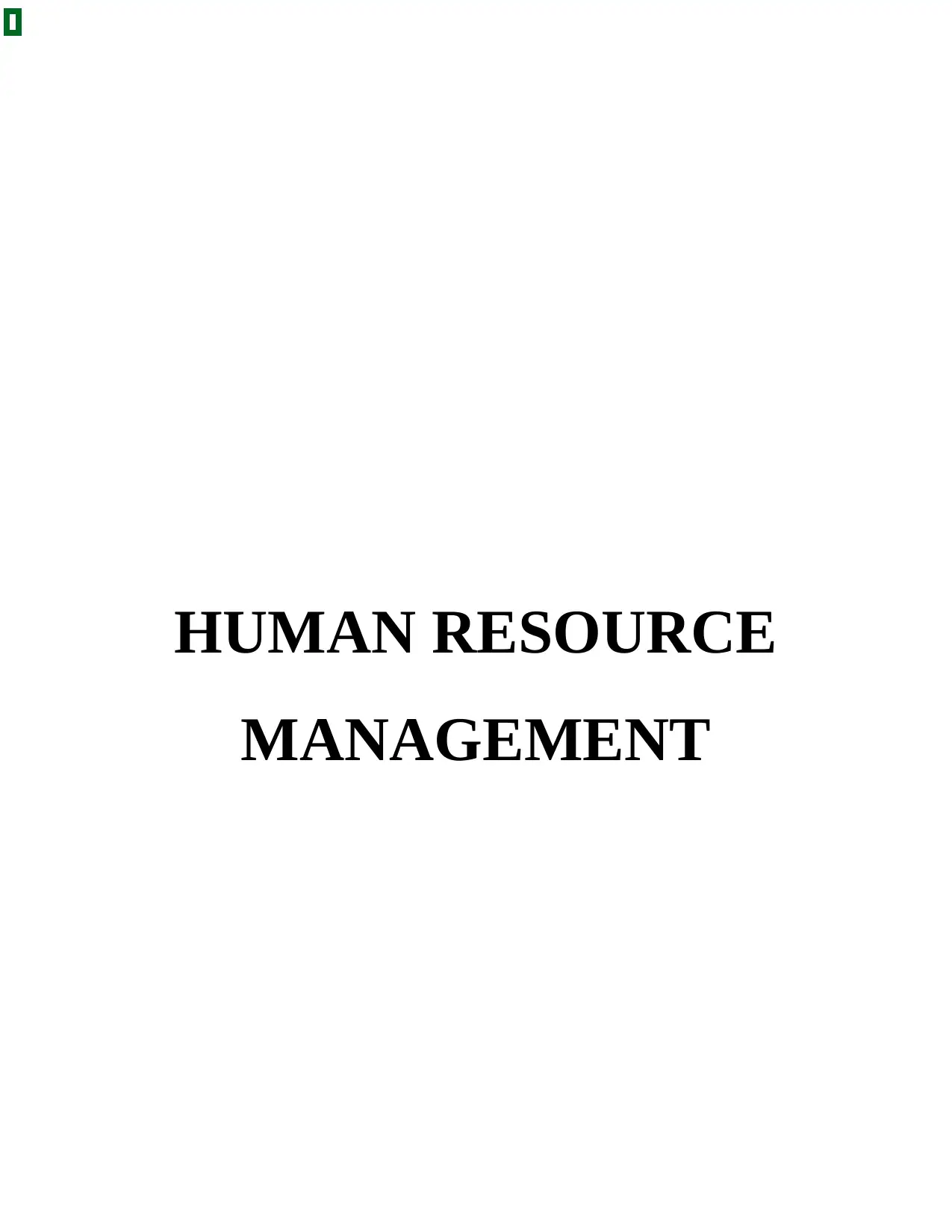
HUMAN RESOURCE
MANAGEMENT
MANAGEMENT
Secure Best Marks with AI Grader
Need help grading? Try our AI Grader for instant feedback on your assignments.
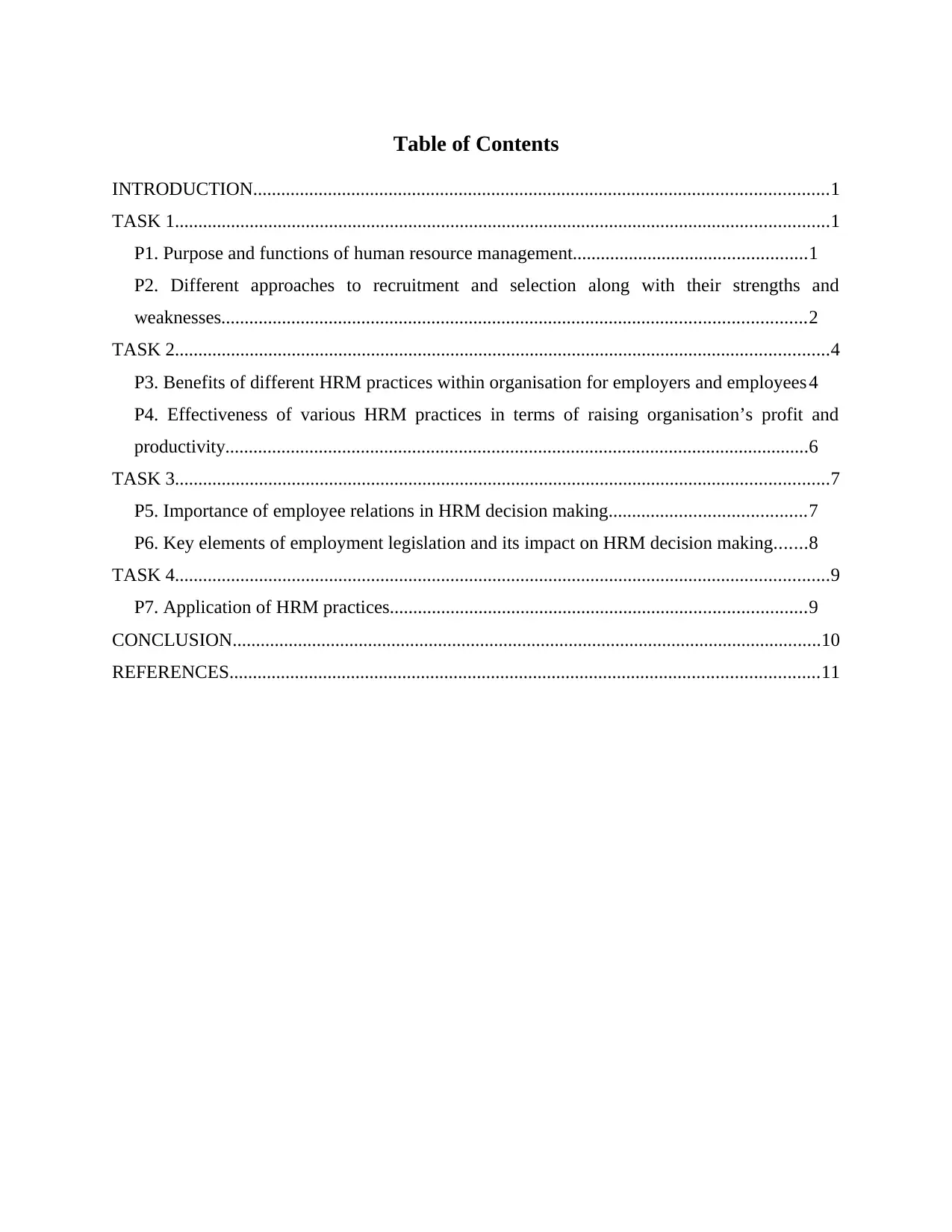
Table of Contents
INTRODUCTION...........................................................................................................................1
TASK 1............................................................................................................................................1
P1. Purpose and functions of human resource management..................................................1
P2. Different approaches to recruitment and selection along with their strengths and
weaknesses.............................................................................................................................2
TASK 2............................................................................................................................................4
P3. Benefits of different HRM practices within organisation for employers and employees 4
P4. Effectiveness of various HRM practices in terms of raising organisation’s profit and
productivity.............................................................................................................................6
TASK 3............................................................................................................................................7
P5. Importance of employee relations in HRM decision making..........................................7
P6. Key elements of employment legislation and its impact on HRM decision making.......8
TASK 4............................................................................................................................................9
P7. Application of HRM practices.........................................................................................9
CONCLUSION..............................................................................................................................10
REFERENCES..............................................................................................................................11
INTRODUCTION...........................................................................................................................1
TASK 1............................................................................................................................................1
P1. Purpose and functions of human resource management..................................................1
P2. Different approaches to recruitment and selection along with their strengths and
weaknesses.............................................................................................................................2
TASK 2............................................................................................................................................4
P3. Benefits of different HRM practices within organisation for employers and employees 4
P4. Effectiveness of various HRM practices in terms of raising organisation’s profit and
productivity.............................................................................................................................6
TASK 3............................................................................................................................................7
P5. Importance of employee relations in HRM decision making..........................................7
P6. Key elements of employment legislation and its impact on HRM decision making.......8
TASK 4............................................................................................................................................9
P7. Application of HRM practices.........................................................................................9
CONCLUSION..............................................................................................................................10
REFERENCES..............................................................................................................................11
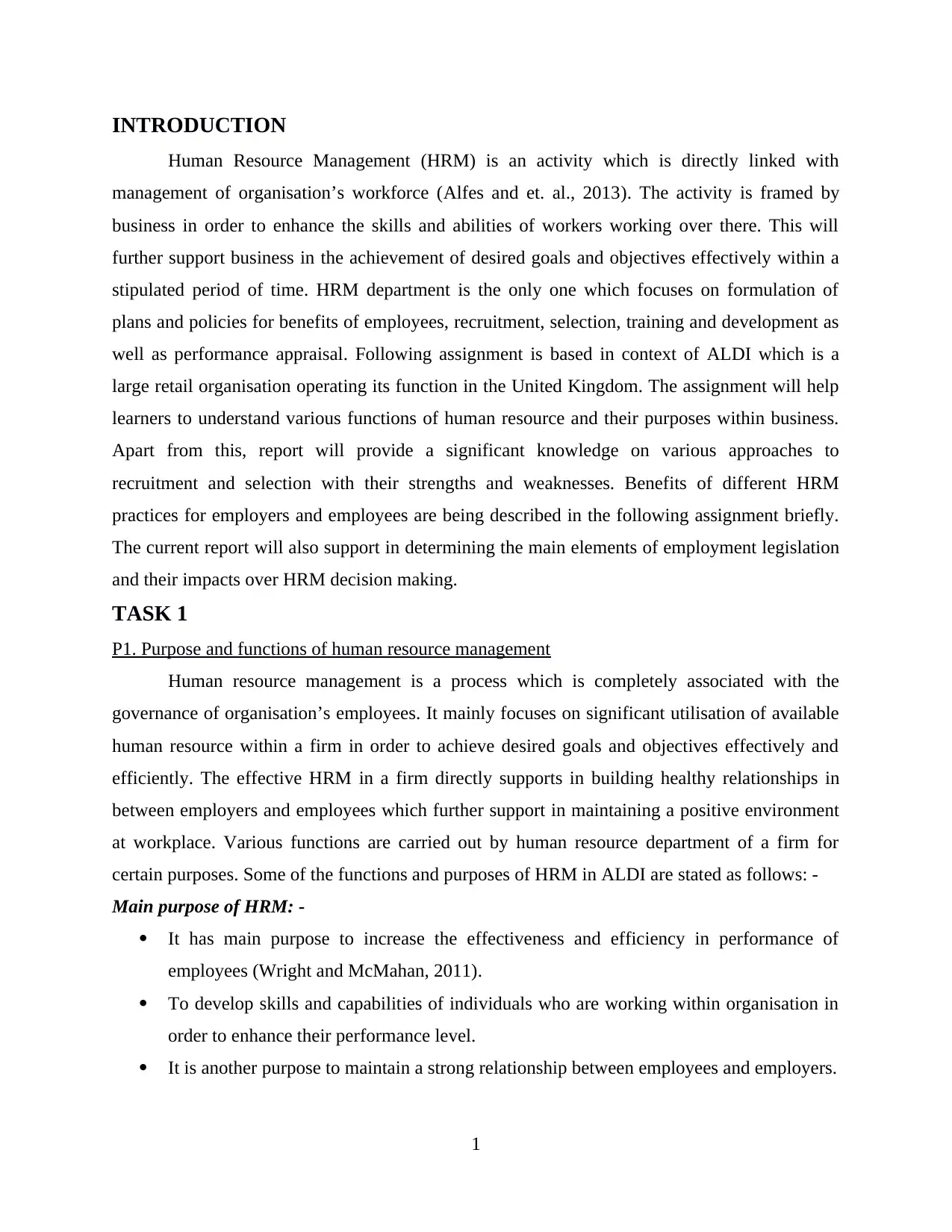
INTRODUCTION
Human Resource Management (HRM) is an activity which is directly linked with
management of organisation’s workforce (Alfes and et. al., 2013). The activity is framed by
business in order to enhance the skills and abilities of workers working over there. This will
further support business in the achievement of desired goals and objectives effectively within a
stipulated period of time. HRM department is the only one which focuses on formulation of
plans and policies for benefits of employees, recruitment, selection, training and development as
well as performance appraisal. Following assignment is based in context of ALDI which is a
large retail organisation operating its function in the United Kingdom. The assignment will help
learners to understand various functions of human resource and their purposes within business.
Apart from this, report will provide a significant knowledge on various approaches to
recruitment and selection with their strengths and weaknesses. Benefits of different HRM
practices for employers and employees are being described in the following assignment briefly.
The current report will also support in determining the main elements of employment legislation
and their impacts over HRM decision making.
TASK 1
P1. Purpose and functions of human resource management
Human resource management is a process which is completely associated with the
governance of organisation’s employees. It mainly focuses on significant utilisation of available
human resource within a firm in order to achieve desired goals and objectives effectively and
efficiently. The effective HRM in a firm directly supports in building healthy relationships in
between employers and employees which further support in maintaining a positive environment
at workplace. Various functions are carried out by human resource department of a firm for
certain purposes. Some of the functions and purposes of HRM in ALDI are stated as follows: -
Main purpose of HRM: -
It has main purpose to increase the effectiveness and efficiency in performance of
employees (Wright and McMahan, 2011).
To develop skills and capabilities of individuals who are working within organisation in
order to enhance their performance level.
It is another purpose to maintain a strong relationship between employees and employers.
1
Human Resource Management (HRM) is an activity which is directly linked with
management of organisation’s workforce (Alfes and et. al., 2013). The activity is framed by
business in order to enhance the skills and abilities of workers working over there. This will
further support business in the achievement of desired goals and objectives effectively within a
stipulated period of time. HRM department is the only one which focuses on formulation of
plans and policies for benefits of employees, recruitment, selection, training and development as
well as performance appraisal. Following assignment is based in context of ALDI which is a
large retail organisation operating its function in the United Kingdom. The assignment will help
learners to understand various functions of human resource and their purposes within business.
Apart from this, report will provide a significant knowledge on various approaches to
recruitment and selection with their strengths and weaknesses. Benefits of different HRM
practices for employers and employees are being described in the following assignment briefly.
The current report will also support in determining the main elements of employment legislation
and their impacts over HRM decision making.
TASK 1
P1. Purpose and functions of human resource management
Human resource management is a process which is completely associated with the
governance of organisation’s employees. It mainly focuses on significant utilisation of available
human resource within a firm in order to achieve desired goals and objectives effectively and
efficiently. The effective HRM in a firm directly supports in building healthy relationships in
between employers and employees which further support in maintaining a positive environment
at workplace. Various functions are carried out by human resource department of a firm for
certain purposes. Some of the functions and purposes of HRM in ALDI are stated as follows: -
Main purpose of HRM: -
It has main purpose to increase the effectiveness and efficiency in performance of
employees (Wright and McMahan, 2011).
To develop skills and capabilities of individuals who are working within organisation in
order to enhance their performance level.
It is another purpose to maintain a strong relationship between employees and employers.
1
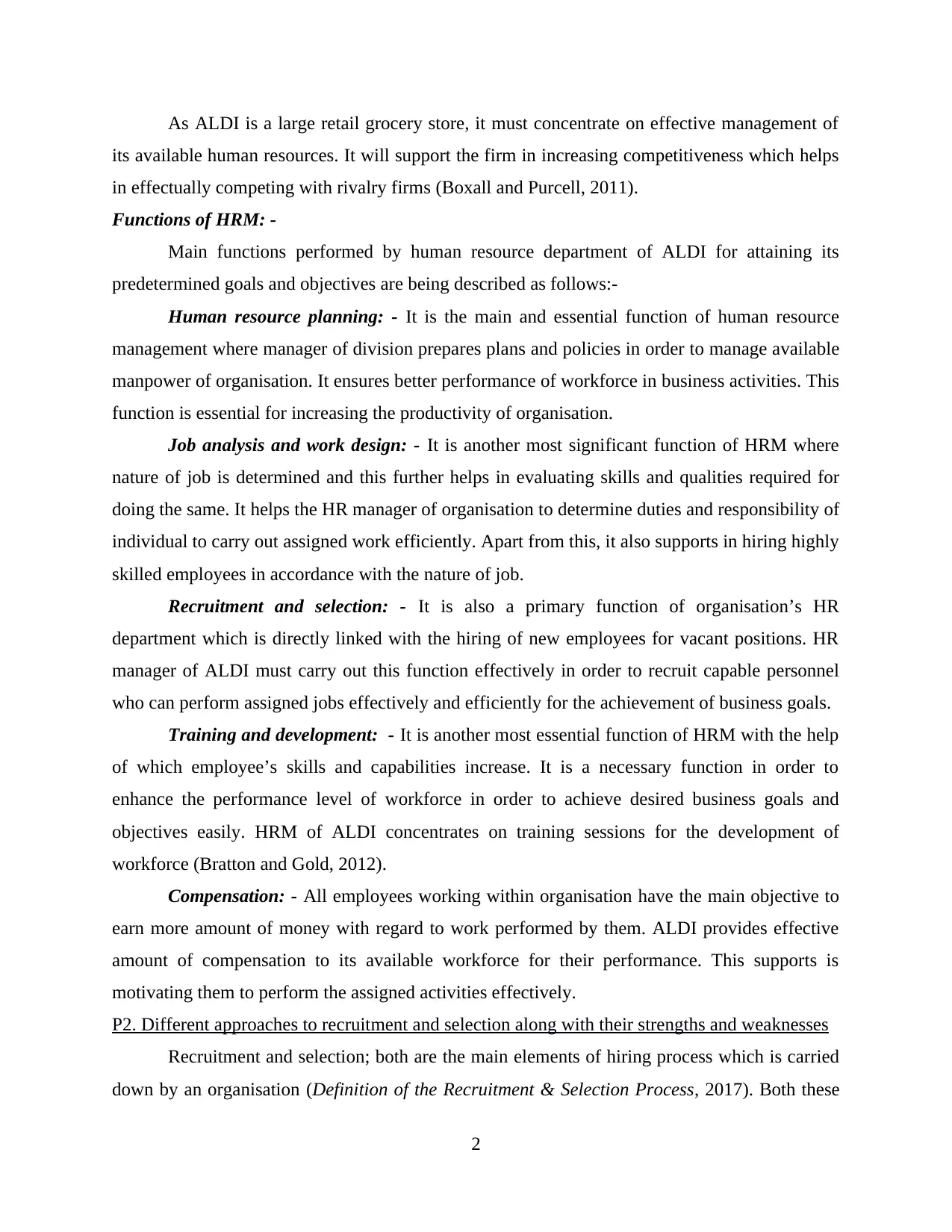
As ALDI is a large retail grocery store, it must concentrate on effective management of
its available human resources. It will support the firm in increasing competitiveness which helps
in effectually competing with rivalry firms (Boxall and Purcell, 2011).
Functions of HRM: -
Main functions performed by human resource department of ALDI for attaining its
predetermined goals and objectives are being described as follows:-
Human resource planning: - It is the main and essential function of human resource
management where manager of division prepares plans and policies in order to manage available
manpower of organisation. It ensures better performance of workforce in business activities. This
function is essential for increasing the productivity of organisation.
Job analysis and work design: - It is another most significant function of HRM where
nature of job is determined and this further helps in evaluating skills and qualities required for
doing the same. It helps the HR manager of organisation to determine duties and responsibility of
individual to carry out assigned work efficiently. Apart from this, it also supports in hiring highly
skilled employees in accordance with the nature of job.
Recruitment and selection: - It is also a primary function of organisation’s HR
department which is directly linked with the hiring of new employees for vacant positions. HR
manager of ALDI must carry out this function effectively in order to recruit capable personnel
who can perform assigned jobs effectively and efficiently for the achievement of business goals.
Training and development: - It is another most essential function of HRM with the help
of which employee’s skills and capabilities increase. It is a necessary function in order to
enhance the performance level of workforce in order to achieve desired business goals and
objectives easily. HRM of ALDI concentrates on training sessions for the development of
workforce (Bratton and Gold, 2012).
Compensation: - All employees working within organisation have the main objective to
earn more amount of money with regard to work performed by them. ALDI provides effective
amount of compensation to its available workforce for their performance. This supports is
motivating them to perform the assigned activities effectively.
P2. Different approaches to recruitment and selection along with their strengths and weaknesses
Recruitment and selection; both are the main elements of hiring process which is carried
down by an organisation (Definition of the Recruitment & Selection Process, 2017). Both these
2
its available human resources. It will support the firm in increasing competitiveness which helps
in effectually competing with rivalry firms (Boxall and Purcell, 2011).
Functions of HRM: -
Main functions performed by human resource department of ALDI for attaining its
predetermined goals and objectives are being described as follows:-
Human resource planning: - It is the main and essential function of human resource
management where manager of division prepares plans and policies in order to manage available
manpower of organisation. It ensures better performance of workforce in business activities. This
function is essential for increasing the productivity of organisation.
Job analysis and work design: - It is another most significant function of HRM where
nature of job is determined and this further helps in evaluating skills and qualities required for
doing the same. It helps the HR manager of organisation to determine duties and responsibility of
individual to carry out assigned work efficiently. Apart from this, it also supports in hiring highly
skilled employees in accordance with the nature of job.
Recruitment and selection: - It is also a primary function of organisation’s HR
department which is directly linked with the hiring of new employees for vacant positions. HR
manager of ALDI must carry out this function effectively in order to recruit capable personnel
who can perform assigned jobs effectively and efficiently for the achievement of business goals.
Training and development: - It is another most essential function of HRM with the help
of which employee’s skills and capabilities increase. It is a necessary function in order to
enhance the performance level of workforce in order to achieve desired business goals and
objectives easily. HRM of ALDI concentrates on training sessions for the development of
workforce (Bratton and Gold, 2012).
Compensation: - All employees working within organisation have the main objective to
earn more amount of money with regard to work performed by them. ALDI provides effective
amount of compensation to its available workforce for their performance. This supports is
motivating them to perform the assigned activities effectively.
P2. Different approaches to recruitment and selection along with their strengths and weaknesses
Recruitment and selection; both are the main elements of hiring process which is carried
down by an organisation (Definition of the Recruitment & Selection Process, 2017). Both these
2
Secure Best Marks with AI Grader
Need help grading? Try our AI Grader for instant feedback on your assignments.
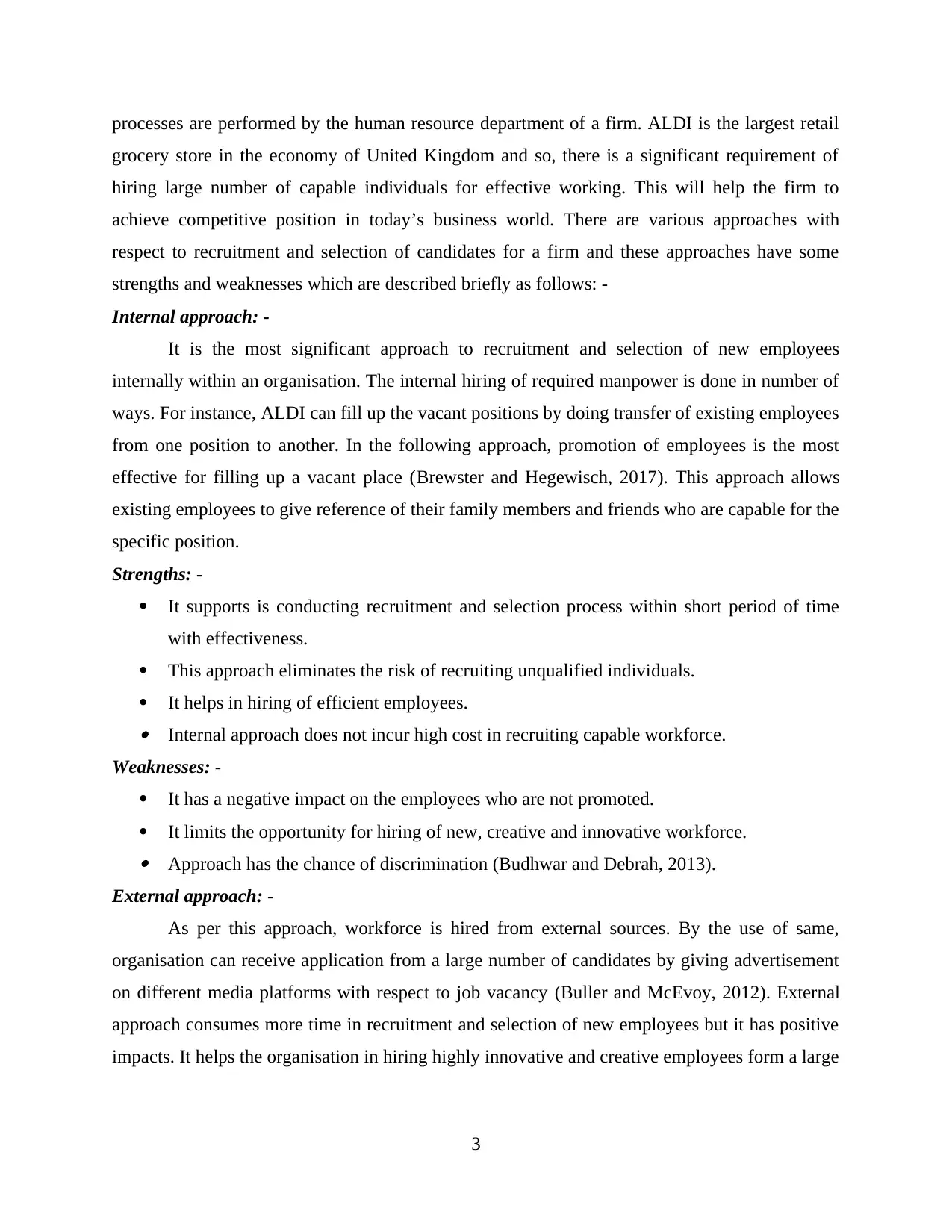
processes are performed by the human resource department of a firm. ALDI is the largest retail
grocery store in the economy of United Kingdom and so, there is a significant requirement of
hiring large number of capable individuals for effective working. This will help the firm to
achieve competitive position in today’s business world. There are various approaches with
respect to recruitment and selection of candidates for a firm and these approaches have some
strengths and weaknesses which are described briefly as follows: -
Internal approach: -
It is the most significant approach to recruitment and selection of new employees
internally within an organisation. The internal hiring of required manpower is done in number of
ways. For instance, ALDI can fill up the vacant positions by doing transfer of existing employees
from one position to another. In the following approach, promotion of employees is the most
effective for filling up a vacant place (Brewster and Hegewisch, 2017). This approach allows
existing employees to give reference of their family members and friends who are capable for the
specific position.
Strengths: -
It supports is conducting recruitment and selection process within short period of time
with effectiveness.
This approach eliminates the risk of recruiting unqualified individuals.
It helps in hiring of efficient employees. Internal approach does not incur high cost in recruiting capable workforce.
Weaknesses: -
It has a negative impact on the employees who are not promoted.
It limits the opportunity for hiring of new, creative and innovative workforce. Approach has the chance of discrimination (Budhwar and Debrah, 2013).
External approach: -
As per this approach, workforce is hired from external sources. By the use of same,
organisation can receive application from a large number of candidates by giving advertisement
on different media platforms with respect to job vacancy (Buller and McEvoy, 2012). External
approach consumes more time in recruitment and selection of new employees but it has positive
impacts. It helps the organisation in hiring highly innovative and creative employees form a large
3
grocery store in the economy of United Kingdom and so, there is a significant requirement of
hiring large number of capable individuals for effective working. This will help the firm to
achieve competitive position in today’s business world. There are various approaches with
respect to recruitment and selection of candidates for a firm and these approaches have some
strengths and weaknesses which are described briefly as follows: -
Internal approach: -
It is the most significant approach to recruitment and selection of new employees
internally within an organisation. The internal hiring of required manpower is done in number of
ways. For instance, ALDI can fill up the vacant positions by doing transfer of existing employees
from one position to another. In the following approach, promotion of employees is the most
effective for filling up a vacant place (Brewster and Hegewisch, 2017). This approach allows
existing employees to give reference of their family members and friends who are capable for the
specific position.
Strengths: -
It supports is conducting recruitment and selection process within short period of time
with effectiveness.
This approach eliminates the risk of recruiting unqualified individuals.
It helps in hiring of efficient employees. Internal approach does not incur high cost in recruiting capable workforce.
Weaknesses: -
It has a negative impact on the employees who are not promoted.
It limits the opportunity for hiring of new, creative and innovative workforce. Approach has the chance of discrimination (Budhwar and Debrah, 2013).
External approach: -
As per this approach, workforce is hired from external sources. By the use of same,
organisation can receive application from a large number of candidates by giving advertisement
on different media platforms with respect to job vacancy (Buller and McEvoy, 2012). External
approach consumes more time in recruitment and selection of new employees but it has positive
impacts. It helps the organisation in hiring highly innovative and creative employees form a large
3
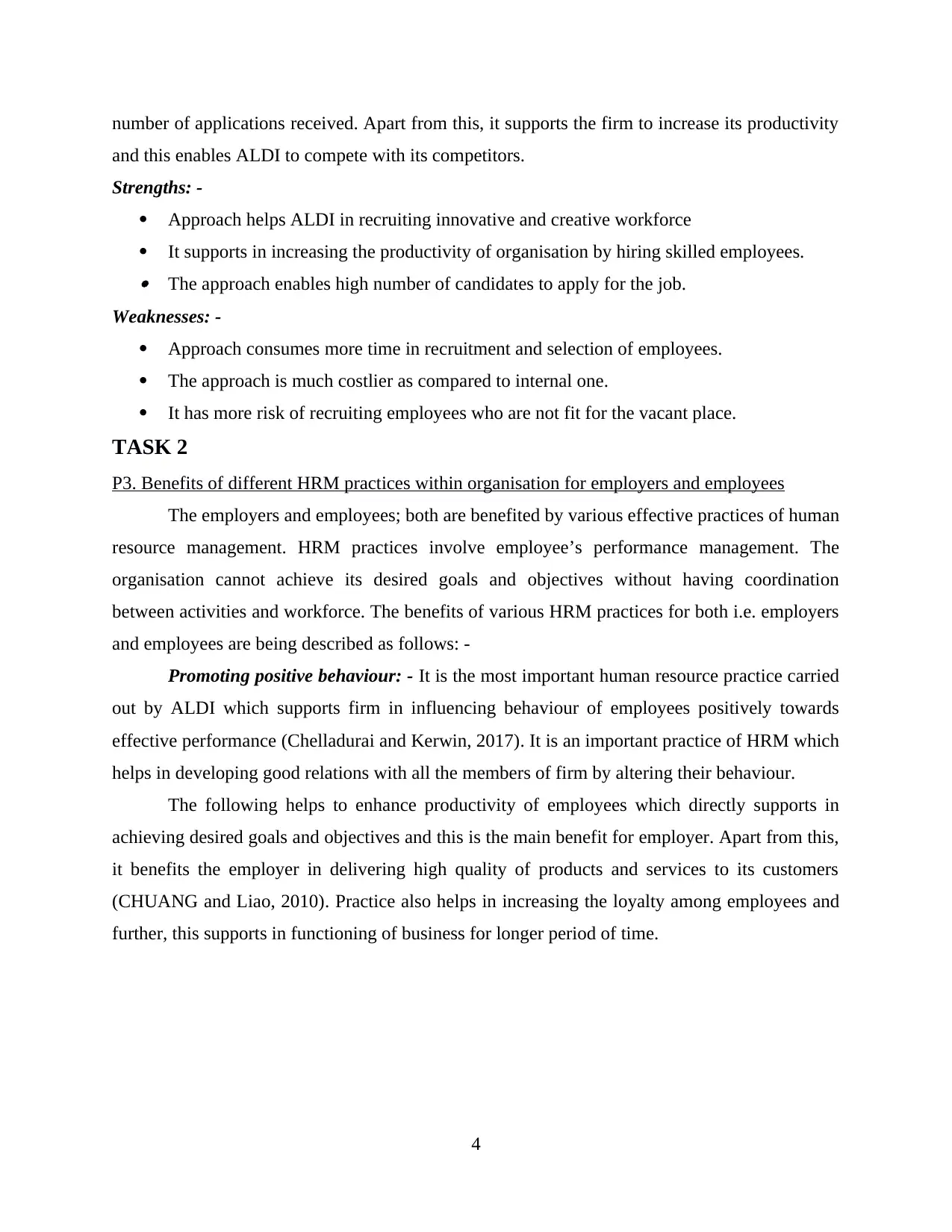
number of applications received. Apart from this, it supports the firm to increase its productivity
and this enables ALDI to compete with its competitors.
Strengths: -
Approach helps ALDI in recruiting innovative and creative workforce
It supports in increasing the productivity of organisation by hiring skilled employees. The approach enables high number of candidates to apply for the job.
Weaknesses: -
Approach consumes more time in recruitment and selection of employees.
The approach is much costlier as compared to internal one.
It has more risk of recruiting employees who are not fit for the vacant place.
TASK 2
P3. Benefits of different HRM practices within organisation for employers and employees
The employers and employees; both are benefited by various effective practices of human
resource management. HRM practices involve employee’s performance management. The
organisation cannot achieve its desired goals and objectives without having coordination
between activities and workforce. The benefits of various HRM practices for both i.e. employers
and employees are being described as follows: -
Promoting positive behaviour: - It is the most important human resource practice carried
out by ALDI which supports firm in influencing behaviour of employees positively towards
effective performance (Chelladurai and Kerwin, 2017). It is an important practice of HRM which
helps in developing good relations with all the members of firm by altering their behaviour.
The following helps to enhance productivity of employees which directly supports in
achieving desired goals and objectives and this is the main benefit for employer. Apart from this,
it benefits the employer in delivering high quality of products and services to its customers
(CHUANG and Liao, 2010). Practice also helps in increasing the loyalty among employees and
further, this supports in functioning of business for longer period of time.
4
and this enables ALDI to compete with its competitors.
Strengths: -
Approach helps ALDI in recruiting innovative and creative workforce
It supports in increasing the productivity of organisation by hiring skilled employees. The approach enables high number of candidates to apply for the job.
Weaknesses: -
Approach consumes more time in recruitment and selection of employees.
The approach is much costlier as compared to internal one.
It has more risk of recruiting employees who are not fit for the vacant place.
TASK 2
P3. Benefits of different HRM practices within organisation for employers and employees
The employers and employees; both are benefited by various effective practices of human
resource management. HRM practices involve employee’s performance management. The
organisation cannot achieve its desired goals and objectives without having coordination
between activities and workforce. The benefits of various HRM practices for both i.e. employers
and employees are being described as follows: -
Promoting positive behaviour: - It is the most important human resource practice carried
out by ALDI which supports firm in influencing behaviour of employees positively towards
effective performance (Chelladurai and Kerwin, 2017). It is an important practice of HRM which
helps in developing good relations with all the members of firm by altering their behaviour.
The following helps to enhance productivity of employees which directly supports in
achieving desired goals and objectives and this is the main benefit for employer. Apart from this,
it benefits the employer in delivering high quality of products and services to its customers
(CHUANG and Liao, 2010). Practice also helps in increasing the loyalty among employees and
further, this supports in functioning of business for longer period of time.
4
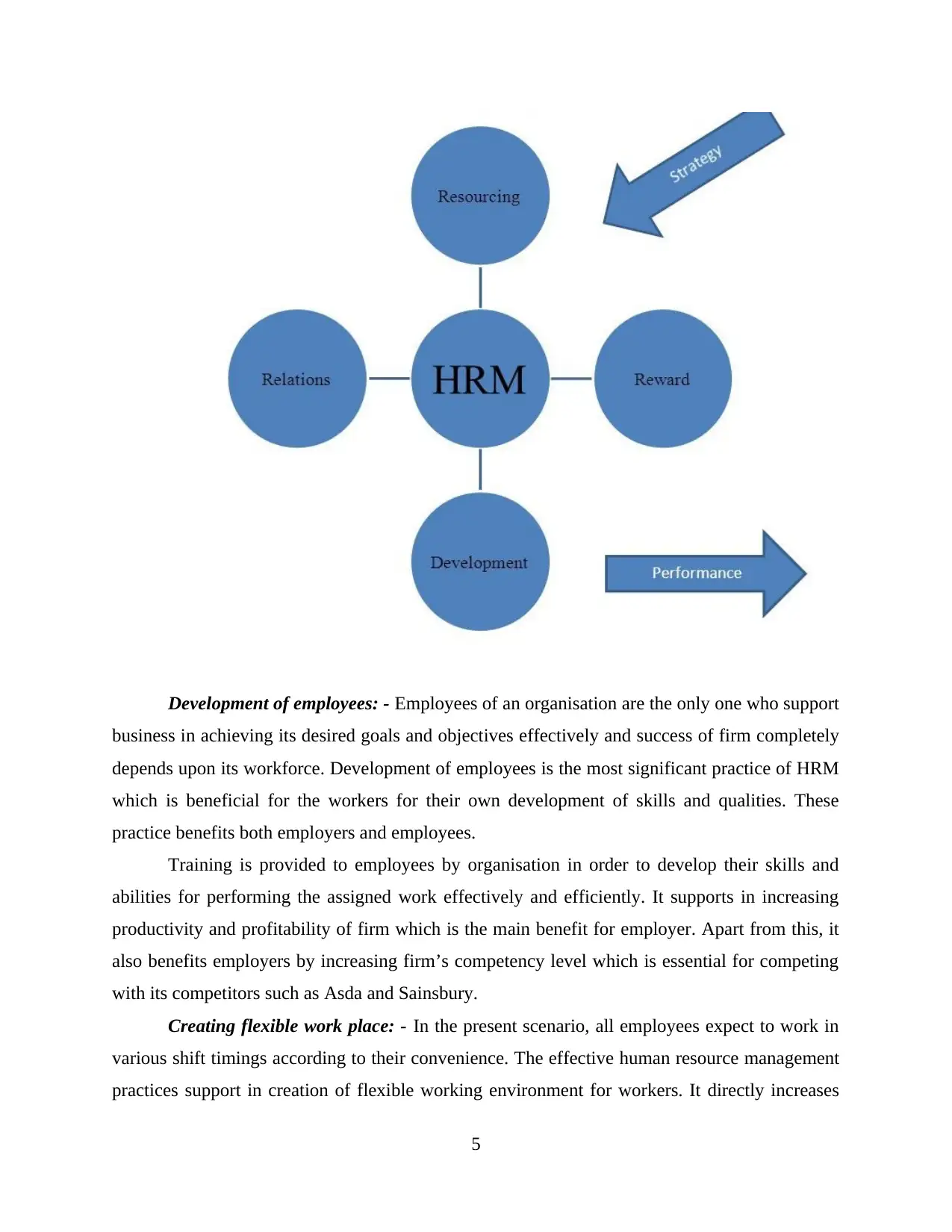
Development of employees: - Employees of an organisation are the only one who support
business in achieving its desired goals and objectives effectively and success of firm completely
depends upon its workforce. Development of employees is the most significant practice of HRM
which is beneficial for the workers for their own development of skills and qualities. These
practice benefits both employers and employees.
Training is provided to employees by organisation in order to develop their skills and
abilities for performing the assigned work effectively and efficiently. It supports in increasing
productivity and profitability of firm which is the main benefit for employer. Apart from this, it
also benefits employers by increasing firm’s competency level which is essential for competing
with its competitors such as Asda and Sainsbury.
Creating flexible work place: - In the present scenario, all employees expect to work in
various shift timings according to their convenience. The effective human resource management
practices support in creation of flexible working environment for workers. It directly increases
5
business in achieving its desired goals and objectives effectively and success of firm completely
depends upon its workforce. Development of employees is the most significant practice of HRM
which is beneficial for the workers for their own development of skills and qualities. These
practice benefits both employers and employees.
Training is provided to employees by organisation in order to develop their skills and
abilities for performing the assigned work effectively and efficiently. It supports in increasing
productivity and profitability of firm which is the main benefit for employer. Apart from this, it
also benefits employers by increasing firm’s competency level which is essential for competing
with its competitors such as Asda and Sainsbury.
Creating flexible work place: - In the present scenario, all employees expect to work in
various shift timings according to their convenience. The effective human resource management
practices support in creation of flexible working environment for workers. It directly increases
5
Paraphrase This Document
Need a fresh take? Get an instant paraphrase of this document with our AI Paraphraser
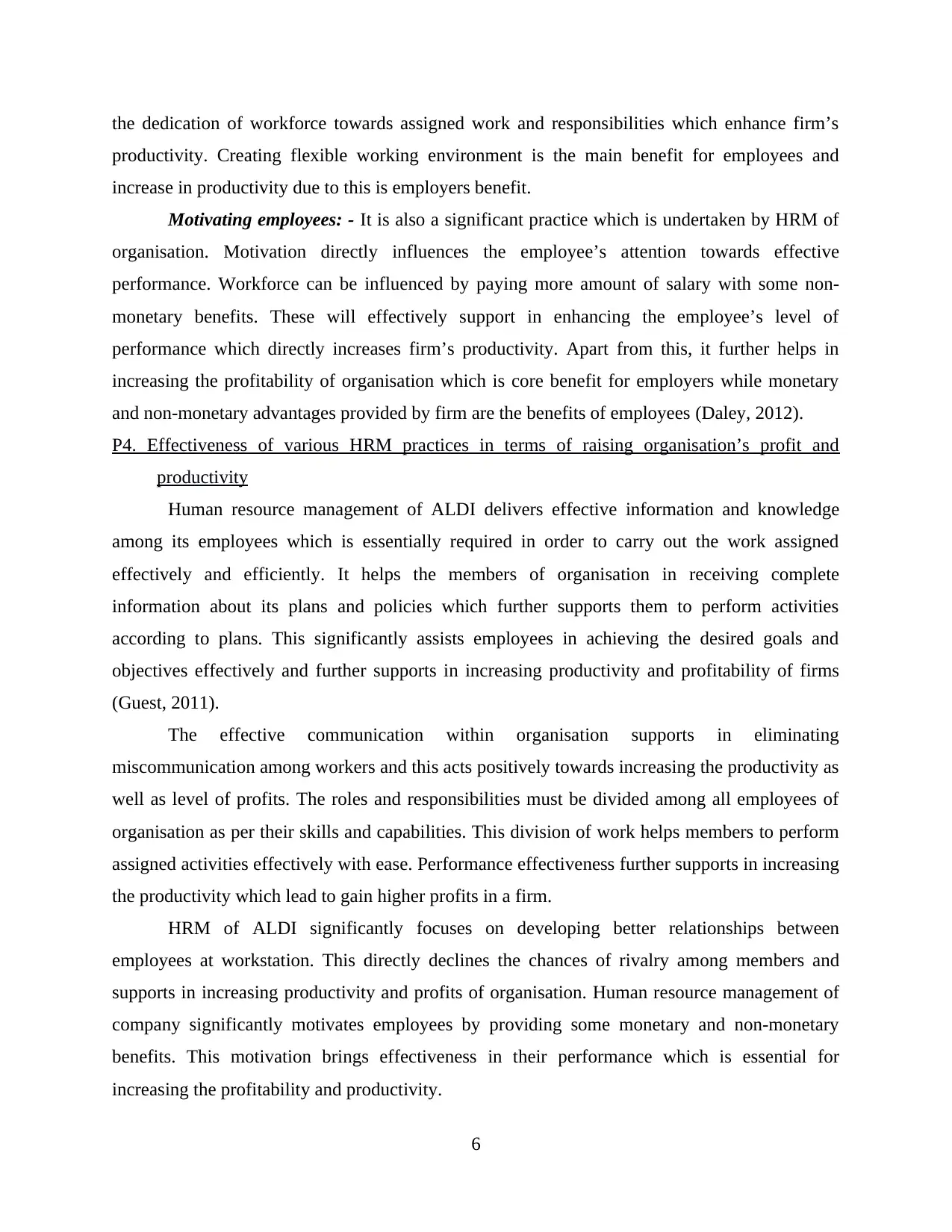
the dedication of workforce towards assigned work and responsibilities which enhance firm’s
productivity. Creating flexible working environment is the main benefit for employees and
increase in productivity due to this is employers benefit.
Motivating employees: - It is also a significant practice which is undertaken by HRM of
organisation. Motivation directly influences the employee’s attention towards effective
performance. Workforce can be influenced by paying more amount of salary with some non-
monetary benefits. These will effectively support in enhancing the employee’s level of
performance which directly increases firm’s productivity. Apart from this, it further helps in
increasing the profitability of organisation which is core benefit for employers while monetary
and non-monetary advantages provided by firm are the benefits of employees (Daley, 2012).
P4. Effectiveness of various HRM practices in terms of raising organisation’s profit and
productivity
Human resource management of ALDI delivers effective information and knowledge
among its employees which is essentially required in order to carry out the work assigned
effectively and efficiently. It helps the members of organisation in receiving complete
information about its plans and policies which further supports them to perform activities
according to plans. This significantly assists employees in achieving the desired goals and
objectives effectively and further supports in increasing productivity and profitability of firms
(Guest, 2011).
The effective communication within organisation supports in eliminating
miscommunication among workers and this acts positively towards increasing the productivity as
well as level of profits. The roles and responsibilities must be divided among all employees of
organisation as per their skills and capabilities. This division of work helps members to perform
assigned activities effectively with ease. Performance effectiveness further supports in increasing
the productivity which lead to gain higher profits in a firm.
HRM of ALDI significantly focuses on developing better relationships between
employees at workstation. This directly declines the chances of rivalry among members and
supports in increasing productivity and profits of organisation. Human resource management of
company significantly motivates employees by providing some monetary and non-monetary
benefits. This motivation brings effectiveness in their performance which is essential for
increasing the profitability and productivity.
6
productivity. Creating flexible working environment is the main benefit for employees and
increase in productivity due to this is employers benefit.
Motivating employees: - It is also a significant practice which is undertaken by HRM of
organisation. Motivation directly influences the employee’s attention towards effective
performance. Workforce can be influenced by paying more amount of salary with some non-
monetary benefits. These will effectively support in enhancing the employee’s level of
performance which directly increases firm’s productivity. Apart from this, it further helps in
increasing the profitability of organisation which is core benefit for employers while monetary
and non-monetary advantages provided by firm are the benefits of employees (Daley, 2012).
P4. Effectiveness of various HRM practices in terms of raising organisation’s profit and
productivity
Human resource management of ALDI delivers effective information and knowledge
among its employees which is essentially required in order to carry out the work assigned
effectively and efficiently. It helps the members of organisation in receiving complete
information about its plans and policies which further supports them to perform activities
according to plans. This significantly assists employees in achieving the desired goals and
objectives effectively and further supports in increasing productivity and profitability of firms
(Guest, 2011).
The effective communication within organisation supports in eliminating
miscommunication among workers and this acts positively towards increasing the productivity as
well as level of profits. The roles and responsibilities must be divided among all employees of
organisation as per their skills and capabilities. This division of work helps members to perform
assigned activities effectively with ease. Performance effectiveness further supports in increasing
the productivity which lead to gain higher profits in a firm.
HRM of ALDI significantly focuses on developing better relationships between
employees at workstation. This directly declines the chances of rivalry among members and
supports in increasing productivity and profits of organisation. Human resource management of
company significantly motivates employees by providing some monetary and non-monetary
benefits. This motivation brings effectiveness in their performance which is essential for
increasing the profitability and productivity.
6
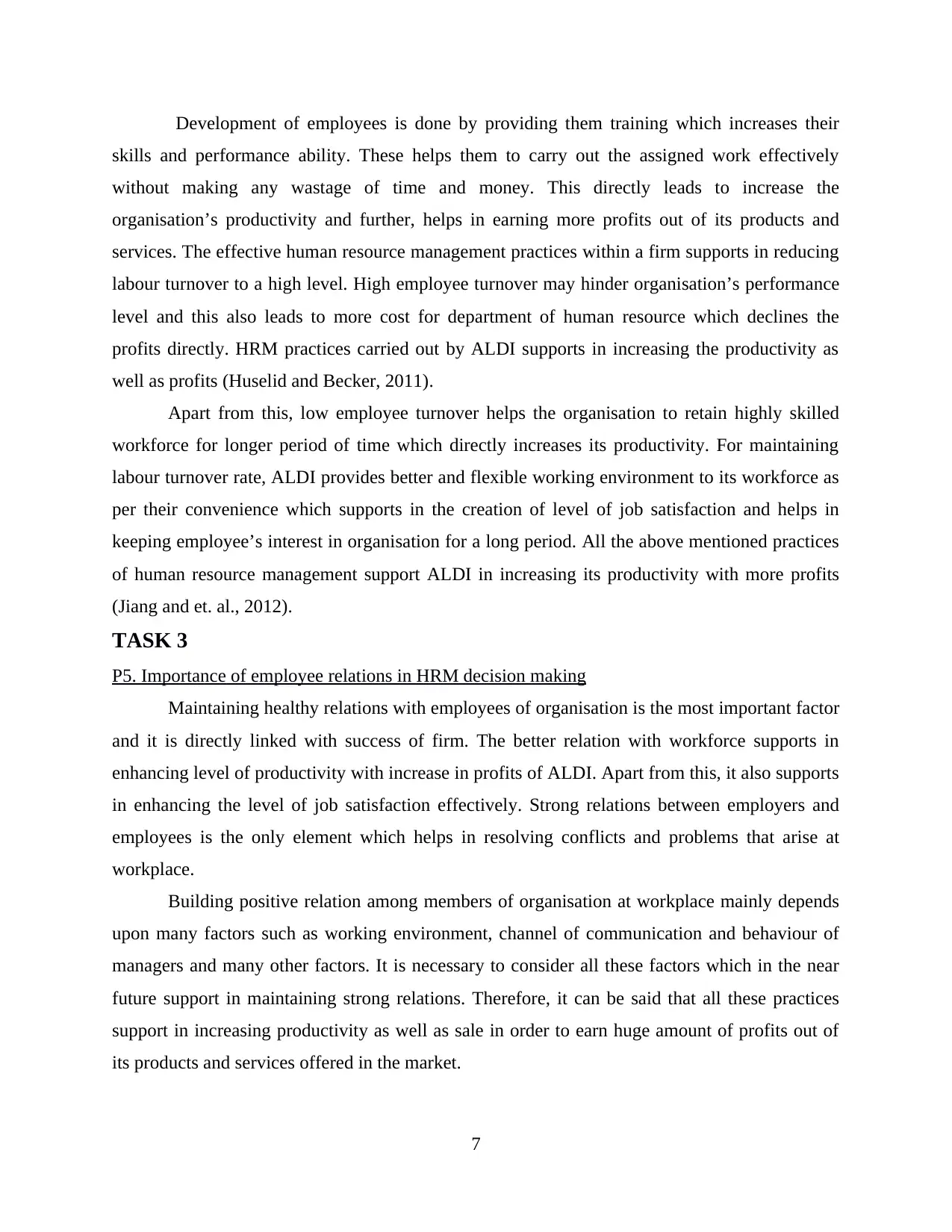
Development of employees is done by providing them training which increases their
skills and performance ability. These helps them to carry out the assigned work effectively
without making any wastage of time and money. This directly leads to increase the
organisation’s productivity and further, helps in earning more profits out of its products and
services. The effective human resource management practices within a firm supports in reducing
labour turnover to a high level. High employee turnover may hinder organisation’s performance
level and this also leads to more cost for department of human resource which declines the
profits directly. HRM practices carried out by ALDI supports in increasing the productivity as
well as profits (Huselid and Becker, 2011).
Apart from this, low employee turnover helps the organisation to retain highly skilled
workforce for longer period of time which directly increases its productivity. For maintaining
labour turnover rate, ALDI provides better and flexible working environment to its workforce as
per their convenience which supports in the creation of level of job satisfaction and helps in
keeping employee’s interest in organisation for a long period. All the above mentioned practices
of human resource management support ALDI in increasing its productivity with more profits
(Jiang and et. al., 2012).
TASK 3
P5. Importance of employee relations in HRM decision making
Maintaining healthy relations with employees of organisation is the most important factor
and it is directly linked with success of firm. The better relation with workforce supports in
enhancing level of productivity with increase in profits of ALDI. Apart from this, it also supports
in enhancing the level of job satisfaction effectively. Strong relations between employers and
employees is the only element which helps in resolving conflicts and problems that arise at
workplace.
Building positive relation among members of organisation at workplace mainly depends
upon many factors such as working environment, channel of communication and behaviour of
managers and many other factors. It is necessary to consider all these factors which in the near
future support in maintaining strong relations. Therefore, it can be said that all these practices
support in increasing productivity as well as sale in order to earn huge amount of profits out of
its products and services offered in the market.
7
skills and performance ability. These helps them to carry out the assigned work effectively
without making any wastage of time and money. This directly leads to increase the
organisation’s productivity and further, helps in earning more profits out of its products and
services. The effective human resource management practices within a firm supports in reducing
labour turnover to a high level. High employee turnover may hinder organisation’s performance
level and this also leads to more cost for department of human resource which declines the
profits directly. HRM practices carried out by ALDI supports in increasing the productivity as
well as profits (Huselid and Becker, 2011).
Apart from this, low employee turnover helps the organisation to retain highly skilled
workforce for longer period of time which directly increases its productivity. For maintaining
labour turnover rate, ALDI provides better and flexible working environment to its workforce as
per their convenience which supports in the creation of level of job satisfaction and helps in
keeping employee’s interest in organisation for a long period. All the above mentioned practices
of human resource management support ALDI in increasing its productivity with more profits
(Jiang and et. al., 2012).
TASK 3
P5. Importance of employee relations in HRM decision making
Maintaining healthy relations with employees of organisation is the most important factor
and it is directly linked with success of firm. The better relation with workforce supports in
enhancing level of productivity with increase in profits of ALDI. Apart from this, it also supports
in enhancing the level of job satisfaction effectively. Strong relations between employers and
employees is the only element which helps in resolving conflicts and problems that arise at
workplace.
Building positive relation among members of organisation at workplace mainly depends
upon many factors such as working environment, channel of communication and behaviour of
managers and many other factors. It is necessary to consider all these factors which in the near
future support in maintaining strong relations. Therefore, it can be said that all these practices
support in increasing productivity as well as sale in order to earn huge amount of profits out of
its products and services offered in the market.
7
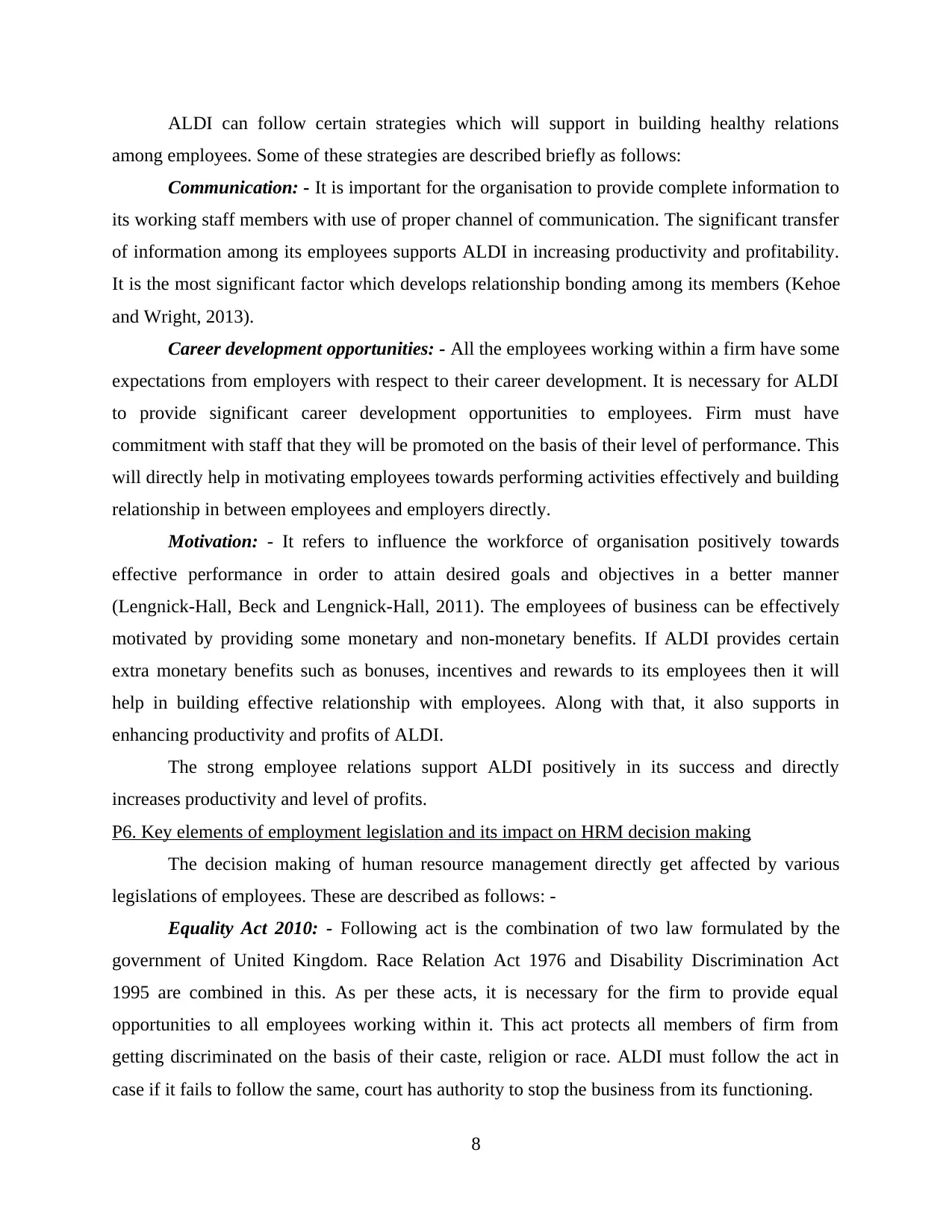
ALDI can follow certain strategies which will support in building healthy relations
among employees. Some of these strategies are described briefly as follows:
Communication: - It is important for the organisation to provide complete information to
its working staff members with use of proper channel of communication. The significant transfer
of information among its employees supports ALDI in increasing productivity and profitability.
It is the most significant factor which develops relationship bonding among its members (Kehoe
and Wright, 2013).
Career development opportunities: - All the employees working within a firm have some
expectations from employers with respect to their career development. It is necessary for ALDI
to provide significant career development opportunities to employees. Firm must have
commitment with staff that they will be promoted on the basis of their level of performance. This
will directly help in motivating employees towards performing activities effectively and building
relationship in between employees and employers directly.
Motivation: - It refers to influence the workforce of organisation positively towards
effective performance in order to attain desired goals and objectives in a better manner
(Lengnick-Hall, Beck and Lengnick-Hall, 2011). The employees of business can be effectively
motivated by providing some monetary and non-monetary benefits. If ALDI provides certain
extra monetary benefits such as bonuses, incentives and rewards to its employees then it will
help in building effective relationship with employees. Along with that, it also supports in
enhancing productivity and profits of ALDI.
The strong employee relations support ALDI positively in its success and directly
increases productivity and level of profits.
P6. Key elements of employment legislation and its impact on HRM decision making
The decision making of human resource management directly get affected by various
legislations of employees. These are described as follows: -
Equality Act 2010: - Following act is the combination of two law formulated by the
government of United Kingdom. Race Relation Act 1976 and Disability Discrimination Act
1995 are combined in this. As per these acts, it is necessary for the firm to provide equal
opportunities to all employees working within it. This act protects all members of firm from
getting discriminated on the basis of their caste, religion or race. ALDI must follow the act in
case if it fails to follow the same, court has authority to stop the business from its functioning.
8
among employees. Some of these strategies are described briefly as follows:
Communication: - It is important for the organisation to provide complete information to
its working staff members with use of proper channel of communication. The significant transfer
of information among its employees supports ALDI in increasing productivity and profitability.
It is the most significant factor which develops relationship bonding among its members (Kehoe
and Wright, 2013).
Career development opportunities: - All the employees working within a firm have some
expectations from employers with respect to their career development. It is necessary for ALDI
to provide significant career development opportunities to employees. Firm must have
commitment with staff that they will be promoted on the basis of their level of performance. This
will directly help in motivating employees towards performing activities effectively and building
relationship in between employees and employers directly.
Motivation: - It refers to influence the workforce of organisation positively towards
effective performance in order to attain desired goals and objectives in a better manner
(Lengnick-Hall, Beck and Lengnick-Hall, 2011). The employees of business can be effectively
motivated by providing some monetary and non-monetary benefits. If ALDI provides certain
extra monetary benefits such as bonuses, incentives and rewards to its employees then it will
help in building effective relationship with employees. Along with that, it also supports in
enhancing productivity and profits of ALDI.
The strong employee relations support ALDI positively in its success and directly
increases productivity and level of profits.
P6. Key elements of employment legislation and its impact on HRM decision making
The decision making of human resource management directly get affected by various
legislations of employees. These are described as follows: -
Equality Act 2010: - Following act is the combination of two law formulated by the
government of United Kingdom. Race Relation Act 1976 and Disability Discrimination Act
1995 are combined in this. As per these acts, it is necessary for the firm to provide equal
opportunities to all employees working within it. This act protects all members of firm from
getting discriminated on the basis of their caste, religion or race. ALDI must follow the act in
case if it fails to follow the same, court has authority to stop the business from its functioning.
8
Secure Best Marks with AI Grader
Need help grading? Try our AI Grader for instant feedback on your assignments.
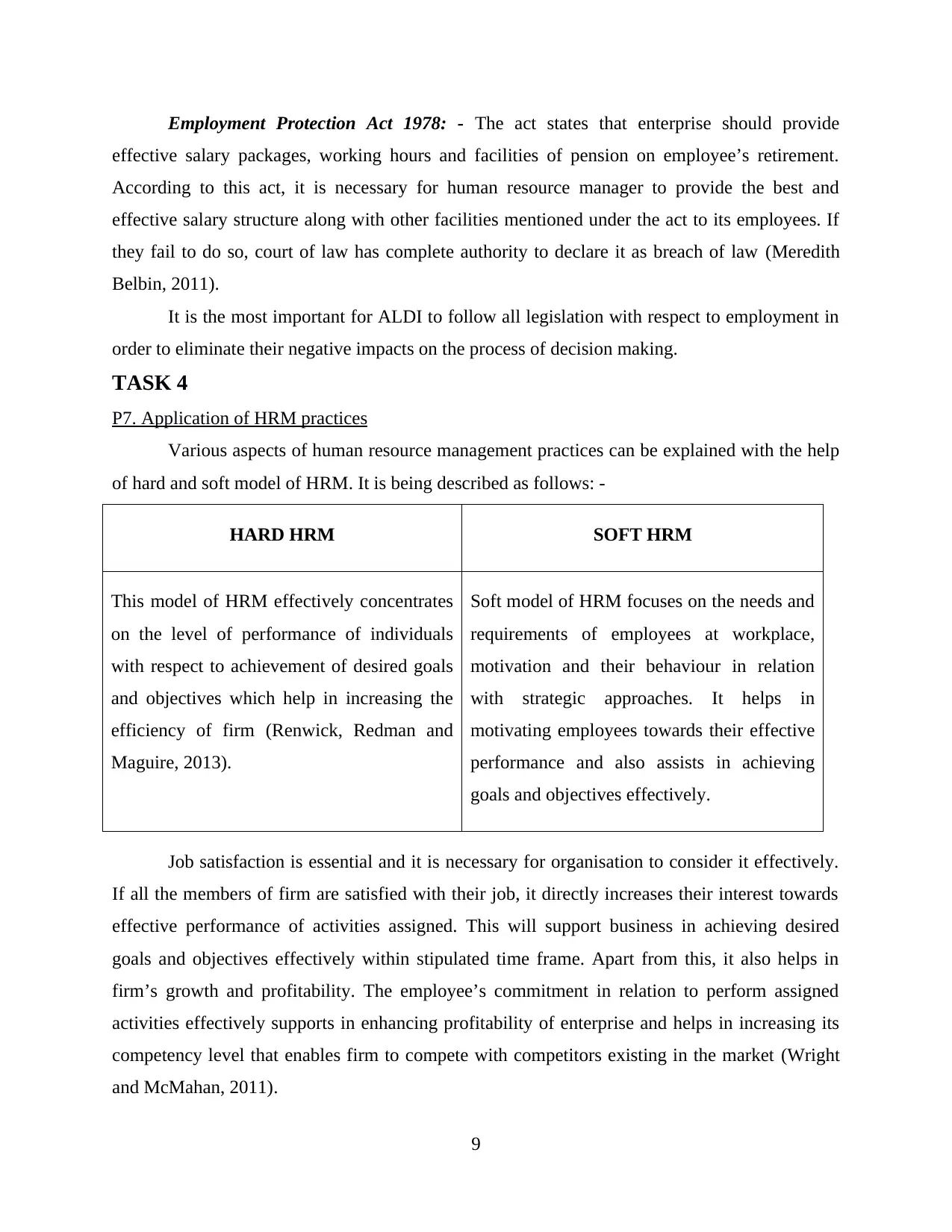
Employment Protection Act 1978: - The act states that enterprise should provide
effective salary packages, working hours and facilities of pension on employee’s retirement.
According to this act, it is necessary for human resource manager to provide the best and
effective salary structure along with other facilities mentioned under the act to its employees. If
they fail to do so, court of law has complete authority to declare it as breach of law (Meredith
Belbin, 2011).
It is the most important for ALDI to follow all legislation with respect to employment in
order to eliminate their negative impacts on the process of decision making.
TASK 4
P7. Application of HRM practices
Various aspects of human resource management practices can be explained with the help
of hard and soft model of HRM. It is being described as follows: -
HARD HRM SOFT HRM
This model of HRM effectively concentrates
on the level of performance of individuals
with respect to achievement of desired goals
and objectives which help in increasing the
efficiency of firm (Renwick, Redman and
Maguire, 2013).
Soft model of HRM focuses on the needs and
requirements of employees at workplace,
motivation and their behaviour in relation
with strategic approaches. It helps in
motivating employees towards their effective
performance and also assists in achieving
goals and objectives effectively.
Job satisfaction is essential and it is necessary for organisation to consider it effectively.
If all the members of firm are satisfied with their job, it directly increases their interest towards
effective performance of activities assigned. This will support business in achieving desired
goals and objectives effectively within stipulated time frame. Apart from this, it also helps in
firm’s growth and profitability. The employee’s commitment in relation to perform assigned
activities effectively supports in enhancing profitability of enterprise and helps in increasing its
competency level that enables firm to compete with competitors existing in the market (Wright
and McMahan, 2011).
9
effective salary packages, working hours and facilities of pension on employee’s retirement.
According to this act, it is necessary for human resource manager to provide the best and
effective salary structure along with other facilities mentioned under the act to its employees. If
they fail to do so, court of law has complete authority to declare it as breach of law (Meredith
Belbin, 2011).
It is the most important for ALDI to follow all legislation with respect to employment in
order to eliminate their negative impacts on the process of decision making.
TASK 4
P7. Application of HRM practices
Various aspects of human resource management practices can be explained with the help
of hard and soft model of HRM. It is being described as follows: -
HARD HRM SOFT HRM
This model of HRM effectively concentrates
on the level of performance of individuals
with respect to achievement of desired goals
and objectives which help in increasing the
efficiency of firm (Renwick, Redman and
Maguire, 2013).
Soft model of HRM focuses on the needs and
requirements of employees at workplace,
motivation and their behaviour in relation
with strategic approaches. It helps in
motivating employees towards their effective
performance and also assists in achieving
goals and objectives effectively.
Job satisfaction is essential and it is necessary for organisation to consider it effectively.
If all the members of firm are satisfied with their job, it directly increases their interest towards
effective performance of activities assigned. This will support business in achieving desired
goals and objectives effectively within stipulated time frame. Apart from this, it also helps in
firm’s growth and profitability. The employee’s commitment in relation to perform assigned
activities effectively supports in enhancing profitability of enterprise and helps in increasing its
competency level that enables firm to compete with competitors existing in the market (Wright
and McMahan, 2011).
9
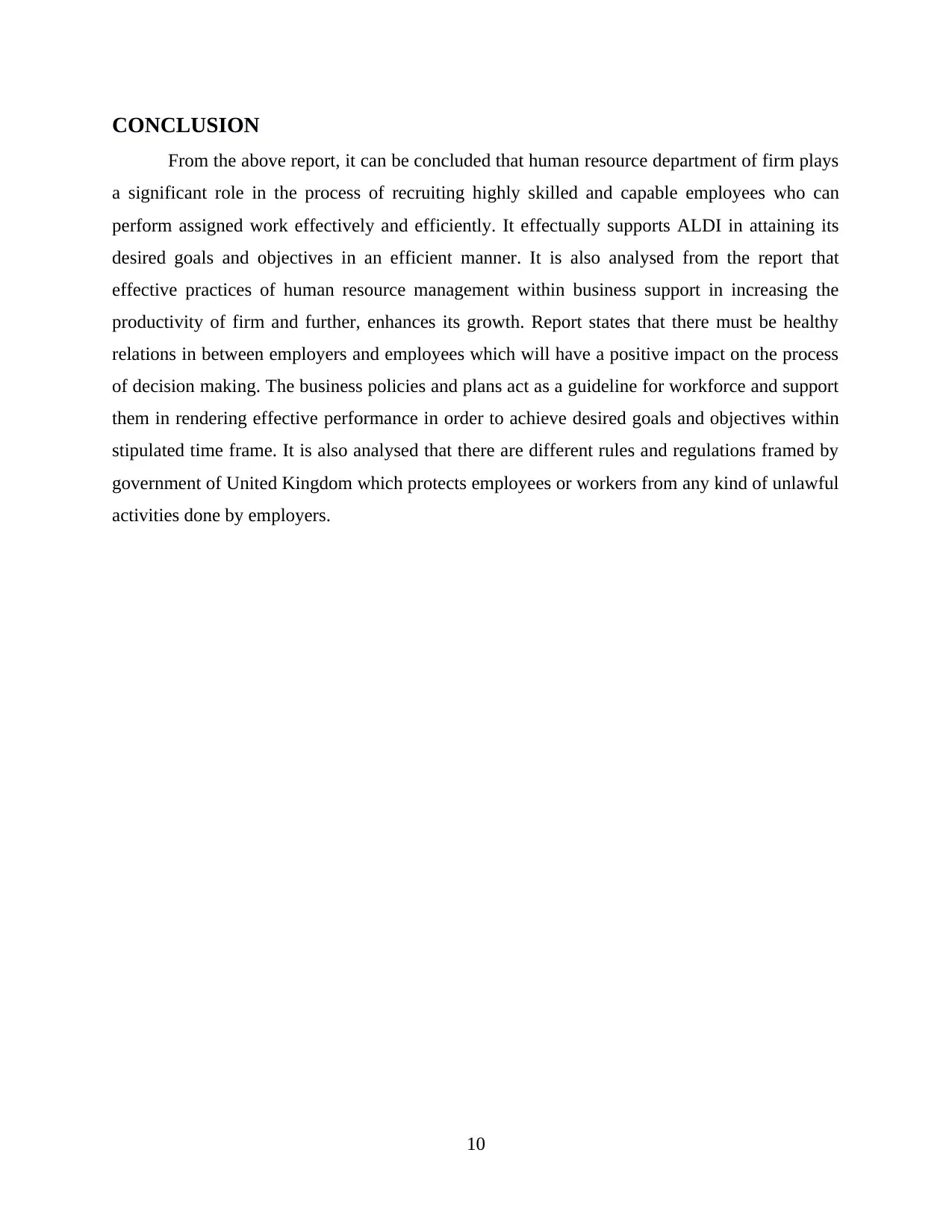
CONCLUSION
From the above report, it can be concluded that human resource department of firm plays
a significant role in the process of recruiting highly skilled and capable employees who can
perform assigned work effectively and efficiently. It effectually supports ALDI in attaining its
desired goals and objectives in an efficient manner. It is also analysed from the report that
effective practices of human resource management within business support in increasing the
productivity of firm and further, enhances its growth. Report states that there must be healthy
relations in between employers and employees which will have a positive impact on the process
of decision making. The business policies and plans act as a guideline for workforce and support
them in rendering effective performance in order to achieve desired goals and objectives within
stipulated time frame. It is also analysed that there are different rules and regulations framed by
government of United Kingdom which protects employees or workers from any kind of unlawful
activities done by employers.
10
From the above report, it can be concluded that human resource department of firm plays
a significant role in the process of recruiting highly skilled and capable employees who can
perform assigned work effectively and efficiently. It effectually supports ALDI in attaining its
desired goals and objectives in an efficient manner. It is also analysed from the report that
effective practices of human resource management within business support in increasing the
productivity of firm and further, enhances its growth. Report states that there must be healthy
relations in between employers and employees which will have a positive impact on the process
of decision making. The business policies and plans act as a guideline for workforce and support
them in rendering effective performance in order to achieve desired goals and objectives within
stipulated time frame. It is also analysed that there are different rules and regulations framed by
government of United Kingdom which protects employees or workers from any kind of unlawful
activities done by employers.
10
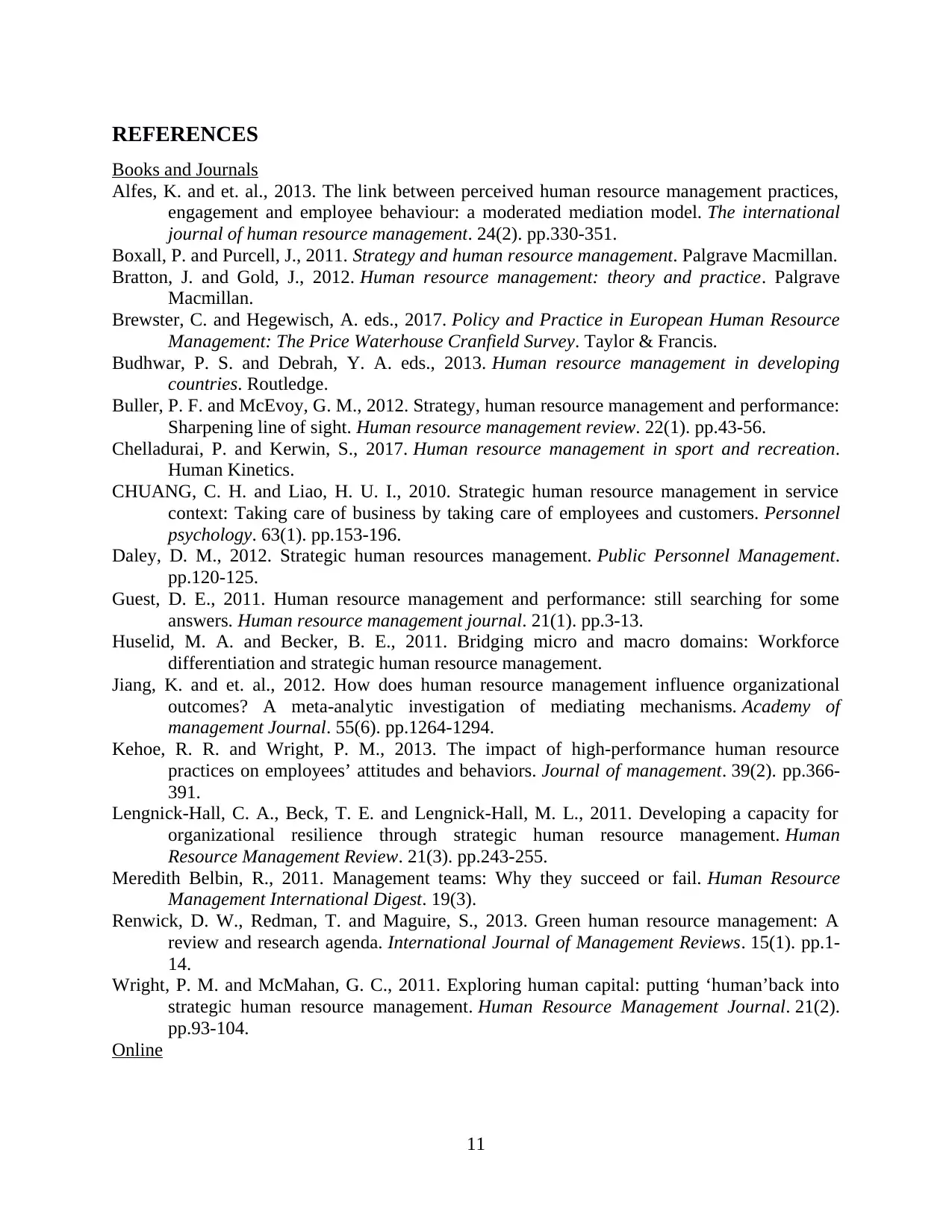
REFERENCES
Books and Journals
Alfes, K. and et. al., 2013. The link between perceived human resource management practices,
engagement and employee behaviour: a moderated mediation model. The international
journal of human resource management. 24(2). pp.330-351.
Boxall, P. and Purcell, J., 2011. Strategy and human resource management. Palgrave Macmillan.
Bratton, J. and Gold, J., 2012. Human resource management: theory and practice. Palgrave
Macmillan.
Brewster, C. and Hegewisch, A. eds., 2017. Policy and Practice in European Human Resource
Management: The Price Waterhouse Cranfield Survey. Taylor & Francis.
Budhwar, P. S. and Debrah, Y. A. eds., 2013. Human resource management in developing
countries. Routledge.
Buller, P. F. and McEvoy, G. M., 2012. Strategy, human resource management and performance:
Sharpening line of sight. Human resource management review. 22(1). pp.43-56.
Chelladurai, P. and Kerwin, S., 2017. Human resource management in sport and recreation.
Human Kinetics.
CHUANG, C. H. and Liao, H. U. I., 2010. Strategic human resource management in service
context: Taking care of business by taking care of employees and customers. Personnel
psychology. 63(1). pp.153-196.
Daley, D. M., 2012. Strategic human resources management. Public Personnel Management.
pp.120-125.
Guest, D. E., 2011. Human resource management and performance: still searching for some
answers. Human resource management journal. 21(1). pp.3-13.
Huselid, M. A. and Becker, B. E., 2011. Bridging micro and macro domains: Workforce
differentiation and strategic human resource management.
Jiang, K. and et. al., 2012. How does human resource management influence organizational
outcomes? A meta-analytic investigation of mediating mechanisms. Academy of
management Journal. 55(6). pp.1264-1294.
Kehoe, R. R. and Wright, P. M., 2013. The impact of high-performance human resource
practices on employees’ attitudes and behaviors. Journal of management. 39(2). pp.366-
391.
Lengnick-Hall, C. A., Beck, T. E. and Lengnick-Hall, M. L., 2011. Developing a capacity for
organizational resilience through strategic human resource management. Human
Resource Management Review. 21(3). pp.243-255.
Meredith Belbin, R., 2011. Management teams: Why they succeed or fail. Human Resource
Management International Digest. 19(3).
Renwick, D. W., Redman, T. and Maguire, S., 2013. Green human resource management: A
review and research agenda. International Journal of Management Reviews. 15(1). pp.1-
14.
Wright, P. M. and McMahan, G. C., 2011. Exploring human capital: putting ‘human’back into
strategic human resource management. Human Resource Management Journal. 21(2).
pp.93-104.
Online
11
Books and Journals
Alfes, K. and et. al., 2013. The link between perceived human resource management practices,
engagement and employee behaviour: a moderated mediation model. The international
journal of human resource management. 24(2). pp.330-351.
Boxall, P. and Purcell, J., 2011. Strategy and human resource management. Palgrave Macmillan.
Bratton, J. and Gold, J., 2012. Human resource management: theory and practice. Palgrave
Macmillan.
Brewster, C. and Hegewisch, A. eds., 2017. Policy and Practice in European Human Resource
Management: The Price Waterhouse Cranfield Survey. Taylor & Francis.
Budhwar, P. S. and Debrah, Y. A. eds., 2013. Human resource management in developing
countries. Routledge.
Buller, P. F. and McEvoy, G. M., 2012. Strategy, human resource management and performance:
Sharpening line of sight. Human resource management review. 22(1). pp.43-56.
Chelladurai, P. and Kerwin, S., 2017. Human resource management in sport and recreation.
Human Kinetics.
CHUANG, C. H. and Liao, H. U. I., 2010. Strategic human resource management in service
context: Taking care of business by taking care of employees and customers. Personnel
psychology. 63(1). pp.153-196.
Daley, D. M., 2012. Strategic human resources management. Public Personnel Management.
pp.120-125.
Guest, D. E., 2011. Human resource management and performance: still searching for some
answers. Human resource management journal. 21(1). pp.3-13.
Huselid, M. A. and Becker, B. E., 2011. Bridging micro and macro domains: Workforce
differentiation and strategic human resource management.
Jiang, K. and et. al., 2012. How does human resource management influence organizational
outcomes? A meta-analytic investigation of mediating mechanisms. Academy of
management Journal. 55(6). pp.1264-1294.
Kehoe, R. R. and Wright, P. M., 2013. The impact of high-performance human resource
practices on employees’ attitudes and behaviors. Journal of management. 39(2). pp.366-
391.
Lengnick-Hall, C. A., Beck, T. E. and Lengnick-Hall, M. L., 2011. Developing a capacity for
organizational resilience through strategic human resource management. Human
Resource Management Review. 21(3). pp.243-255.
Meredith Belbin, R., 2011. Management teams: Why they succeed or fail. Human Resource
Management International Digest. 19(3).
Renwick, D. W., Redman, T. and Maguire, S., 2013. Green human resource management: A
review and research agenda. International Journal of Management Reviews. 15(1). pp.1-
14.
Wright, P. M. and McMahan, G. C., 2011. Exploring human capital: putting ‘human’back into
strategic human resource management. Human Resource Management Journal. 21(2).
pp.93-104.
Online
11
Paraphrase This Document
Need a fresh take? Get an instant paraphrase of this document with our AI Paraphraser

Definition of the Recruitment & Selection Process. 2017. [Online]. Available through:
<http://smallbusiness.chron.com/definition-recruitment-selection-process-2526.html>.
[Accessed on 6th August 2017]
12
<http://smallbusiness.chron.com/definition-recruitment-selection-process-2526.html>.
[Accessed on 6th August 2017]
12
1 out of 14
Related Documents
Your All-in-One AI-Powered Toolkit for Academic Success.
+13062052269
info@desklib.com
Available 24*7 on WhatsApp / Email
![[object Object]](/_next/static/media/star-bottom.7253800d.svg)
Unlock your academic potential
© 2024 | Zucol Services PVT LTD | All rights reserved.





